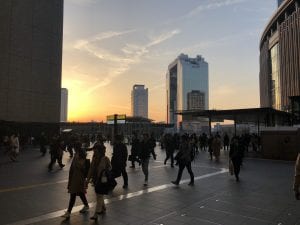Infrastructures of Care
By Laura Haapio-Kirk, on 19 April 2018

Photo (CC BY) Laura Haapio-Kirk
Someone recently told me about how he encourages his 86-year-old mother, whom he lives with, to use her home blood pressure monitor every day and record her readings in a notebook. He said that doctors had prescribed her medication to lower her blood pressure, which she did not like to take. His solution was to turn to traditional Japanese medicine which he explained is tailored to the individual’s body, rather than western medicine which relies on a universal concept of the body. He was able to track the success of this approach through the home monitoring kit, and now her blood pressure is back to normal. This story reveals how infrastructures of care are made up of various integrated systems – that blockages in the form of non-adherence may reveal alternative routes by which people navigate care and self-care.
I am part of a reading group at Osaka University hosted by Gergely Mohacsi and Atsuro Morita. A few weeks ago we discussed Morita’s recent co-edited volume called ‘Infrastructure and Social Complexity’ (Harvey, Bruun, Morita 2017). He explained that a recent focus on infrastructure in social sciences, indeed an ‘infrastrucutural turn’ in anthropology, is a result of infrastructures becoming increasingly precarious and therefore more visible. Ageing infrastructures are becoming more and more tangible as we bump up against cracks in roads and other markers of decay. Infrastructures are systems that should enable things to flow, whether that’s water, electricity, goods, or people. But what happens when people are disconnected from infrastructures, or for whatever reason the flow is blocked?

Photo (CC BY) Laura Haapio-Kirk
I began to think about how smartphones are integral to navigating many of the infrastructures that enmesh us, for example through maps that visually place you within an infrastructure of roads, or health apps that extend the infrastructure of a national health service towards more individualised care. However, as digital technology becomes more integral to health services will people with limited access (through lack of digital literacy, or affordability for example) face increased marginalisation from infrastructures of care? And how are health professionals to identify blockages in the flow of care before it’s too late for individual patients? In such cases where care is not received, it is not only the infrastructure which is revealed to be vulnerable, but individuals themselves.
A couple of days after the seminar I happened to read a newly published article titled ‘Thinking with care infrastructures: people, devices and the home in home blood pressure monitoring’ (Weiner and Will 2018) in which the authors use the concept of care infrastructure to look at the variety of people, things and spaces involved in self-monitoring using a blood pressure device. Their work reveals self-monitoring as a socio-material arrangement that expresses care for self and for others, as opposed to focusing only on the individual and the device: “Specifically, our analysis has drawn attention to the range of local actors and work involved in the practice of self-monitoring, even in the case of consumer technologies. Through this attention to work, monitoring may also come to be seen as involving not just data, but also care amongst kin, family and colleagues.” My intention for my research was always to look at smartphones as situated within wider practices and things including other technologies and people, but thinking specifically in terms of infrastructure expands my scope and gives rise to questions about how multi-layered flows are connected (or not), ranging from state level, to family based care.
References
Harvey, P., Jensen, C. B., Morita, A. (2017). Infrastructure and Social Complexity. Routledge
Weiner, K. and Will, C (2018) ‘Thinking with care infrastructures: people, devices and the home in home blood pressure monitoring’ in Sociology of Health and Illness 40: 270–282. doi:10.1111/1467-9566.12590.
 Close
Close





